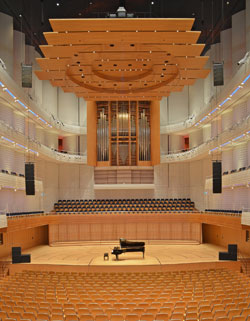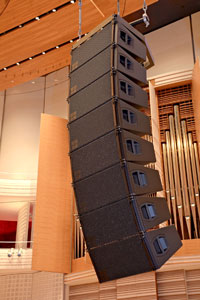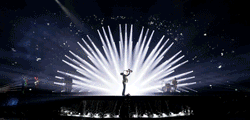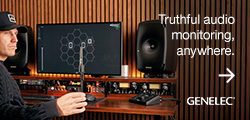![]() From an opening performance given by the Berlin Philharmonic in 1998, the Switzerland’s KKL Luzern Concert Hall was destined to become one of the world’s great performance centres.
From an opening performance given by the Berlin Philharmonic in 1998, the Switzerland’s KKL Luzern Concert Hall was destined to become one of the world’s great performance centres.
Designed by architect Jean Nouvel, its formal opening took place in 2000. Today, it attracts music fans from around the world with a diverse programme of events – and an ambitious new sound installation..
The KKL Luzern is comprised of three distinctive sectors – a conference and meeting room wing with lounges and restaurants, a black box-style multipurpose hall that stages events from rock concerts to general assemblies, and, a Concert Hall with acoustics designed by Artec. The Concert Hall has a remarkably low noise floor of below 20dB, and has mechanically variable room acoustics, which have recently been upgraded by WSDG.
 ‘The acoustical quality of the KKL Luzern Concert Hall is on par with other world-class halls, so the main objective for the new sound reinforcement system was that we achieve the same high-quality level in electroacoustical concerts as we do in classical events,’ explains the facility’s COO, Dr Dominik Isler.
‘The acoustical quality of the KKL Luzern Concert Hall is on par with other world-class halls, so the main objective for the new sound reinforcement system was that we achieve the same high-quality level in electroacoustical concerts as we do in classical events,’ explains the facility’s COO, Dr Dominik Isler.
The hall has a gently rising main floor plus four balcony levels, the lowest of which flows into the organ loft where additional seating brings the total capacity to just under 2,000. The room dimensions correspond to a classic 1:1:2 shoebox, with a height of 22m (72ft), a width of 22m (72ft) and a length of 46m (150ft). The wood stage, meanwhile, comprises 41 adjustable elements. Situated at the front of the house directly above the stage, the hall’s Goll organ boasts 4,387 pipes. This can be closed off with large doors, and a 12m x 8m (40-ft x 26-ft) wide projection screen can then be lowered in front of it. A retractable two-part canopy is located directly above the stage.
Many of the walls are touchpanel-controlled hydraulic panels that can be used to modify the reverberation time of the room. The hall itself has a volume of 17,823m³; when open, the acoustic chambers increase the volume by an additional 6,189m³ – about a third of the its volume. The chambers are treated with varying arrangements of absorbing curtains, providing a variable median reverberation time of between 2.0s and 2.8s. The panels are slightly convex and covered with 24,000 custom designed gypsum relief elements. For reinforced events, the reliefs are covered by white curtains.
Prior to a particular event, the KKL Luzern technical team configure the room based on instructions from the conductor and their experience of past events. Further fine-tuning is accomplished during rehearsal.
‘We have conductors who know the room very well and want it set up exactly to their personal preferences,’ Technical Director Tjark Kuhlmei explains. ‘For example, Claudio Abbado knows precisely the slight change that can be achieved by varying the canopy height by 20cm to produce a subtle, yet more pronounced harp sound.’
The sound system
In addition to the acoustic aspects of the hall’s upgrade, further requirements included the ability to fully retract the loudspeaker system for non-reinforced events; eliminating the need for temporary placement of auxiliary loudspeakers for audience coverage; 360° coverage for spoken word events (also covering the area beside and behind the stage, including the balcony below the organ) and more accurate perception of directionality. Due to the complexity and logistics of the project, it required two years of consulting, planning, contractor selection, supervision of installation and calibration of the technical systems.
 ‘A major issue of the hall is the wide distribution of seats – on five vertical levels surrounding three of the four walls,’ says Dirk Noy, General Manager of WSDG’s Europe Office. ‘The core idea was the realisation that the KKL Luzern Concert Hall is mainly designed for acoustical sources that are placed directly on stage.’
‘A major issue of the hall is the wide distribution of seats – on five vertical levels surrounding three of the four walls,’ says Dirk Noy, General Manager of WSDG’s Europe Office. ‘The core idea was the realisation that the KKL Luzern Concert Hall is mainly designed for acoustical sources that are placed directly on stage.’
Consequently, the main loudspeaker system is installed significantly lower and closer to the stage than the previous solution. This is supplemented by a distributed system whose elements are permanently installed but retractable by motors.
The project was divided into three phases. First was the identification of the requirements, system planning and preparation of specifications. Second cam the on-site evaluation of a total of three loudspeaker system candidates. And finally, the installation planning, supervision and commissioning.
Between them, Phases 1 & 2 determined that d&b loudspeakers would provide the optimum system – both in the technical evaluation (acoustical measurements) and listening tests (questionnaires filled in by a test audience of 20 people with varying backgrounds). The procurement and installation was awarded to auviso, one of Switzerland’s leading system integrators.
The new sound reinforcement system comprises LR hangs of eight d&b audiotechnic V12 units, suspended above the stage front edge. Two additional line arrays cover each of the balconies with five d&b V12 units, and there is a stage edge fill system consisting of two d&b V-Sub and two d&b V12 units each on the right and left, and stage-mounted front fill provided by six d&b E6 units. For events requiring a 360° speech reproduction, a retractable centre cluster is provided with a front section (consisting of 11 d&b T10 units) and a rear section (consisting of three RCF VSA 2050 digitally-controlled column loudspeakers).
The d&b V12 units have a nominal horizontal dispersion of 120°; the vertical tilting is variable from 0-14° degrees. With this arrangement and the algorithms within the D12 amplifier, a cardioid dispersion with significant attenuation of radiation towards the stage can be achieved. The arrays are equipped with cable winding mechanisms that allow the retraction of all loudspeakers not required for a specific performance to a parking position above the canopy.
‘Beyond their sonic qualities, we like the aesthetics of the new system, being an inconspicuous, slim line array,’ Kuhlmei says, ‘With the subs on stage, we can flexibly adjust the low frequency reproduction as required, or not use them at all, for example for pure speech events.’
Completing the system is a Yamaha DME digital mixing system, which feeds digital audio to the amplifier/controllers driving the d&b audiotechnik system via AES/EBU at 96kHz sample rate.
Currently lined up, concerts by The Big Chris Barber Band, the Münchner Symphoniker and Star Trek - Live to Projection, feraturing the 21st Century Symphony Orchestra & Chorus, demonstrate both the variety of the KKL Luzern Concert Hall programmes, and the flexibility of its acoustics and sound installation.
More: www.kkl-luzern.ch
More: www.dbaudio.com
More: www.wsdg.com












